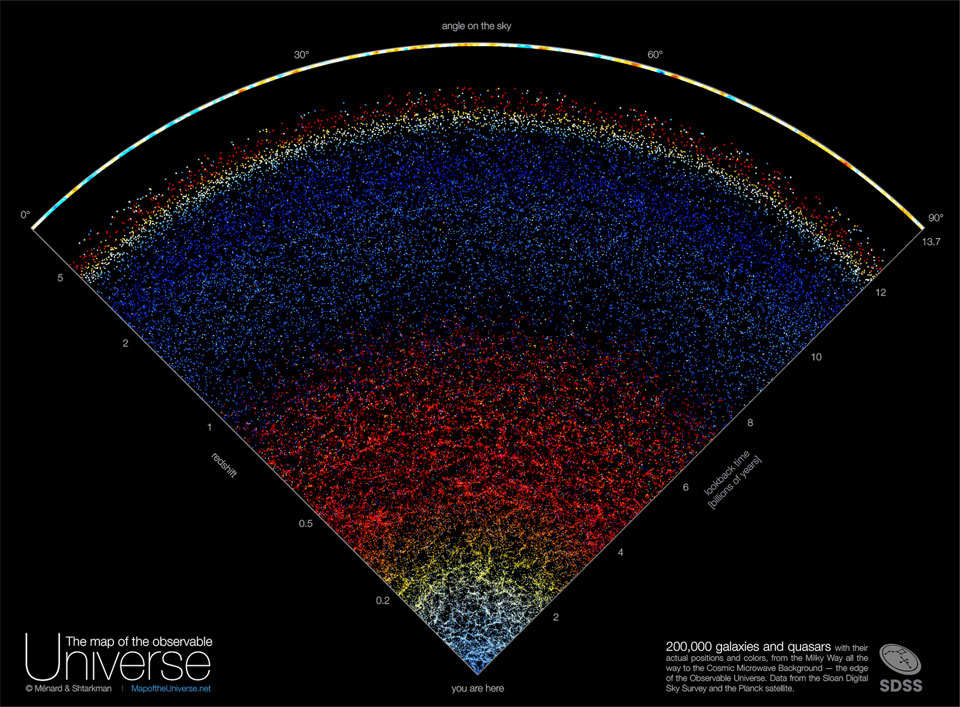05. July 2023
可觀測宇宙 ê 分佈圖

探索宇宙1!逐工會揀一幅無仝款 ê 影像抑是相片,𤆬你熟似咱這个迷人 ê 宇宙,閣有專業天文學者2為你3解說4。
- 原始文章:A Map of the Observable Universe
- 影像來源 kah 版權:B. Ménard & N. Shtarkman; 資料:SDSS, Planck, JHU, Sloan, NASA, ESA
- 閣較濟清楚 ê 地圖:今仔日 ê APOD
- 台文翻譯:An-Li Tsai (NCU)
[漢羅] 可觀測宇宙 ê 分佈圖
你若是會當看著 可觀測宇宙 ê 邊界,毋知會按怎? 你會當看著星系、星系、星系、kah 呃,類星體。 類星體其實是遙遠 星系 光 iàⁿ-iàⁿ ê 中心區。 這張 分佈圖 是為著欲予咱人類 tùi 看會著 ê 上大規模 ê 宇宙有閣較好 ê 理解,才做出來--ê。 這是 ùi 2000 年 到 2020 年 ê SDSS 巡天計畫 ê 星系 kah 類星體 地圖,差不多是 可觀測宇宙 ê 邊界。 這張 pizza 形 ê 影像是巡天觀測 ê 其中一區,這區包括 宇宙回溯時間(就是天體發出 ê 光行到地球 ê 時間)120 億年前、宇宙紅移 5 以內 ê 20 萬个 星系 kah 類星體。 插圖 下面 ê 部份,差不多每一點攏代表一个 星系。較暗 ê 紅色光點,表示 紅移 較大,距離較遠。 仝款,頂懸 ê 部份,嘛差不多每一點攏代表一个遙遠 ê 類星體,其中藍色光點是比紅色光點較近。 Tī 足濟新發現 攏有清楚看著星系 kah 星系之間 ê 重力,會 kā 較近 ê 宇宙 堅凍 起來,比 遙遠宇宙 產生 閣較濟宇宙雲絲結構。
[POJ] Khó-koan-chhek Ú-tiū ê Hun-pò͘-tô͘
Lí nā-sī ē-tàng khòaⁿ-tio̍h khó-koan-chhek ú-tiū ê pian-kài, m̄-chai ē án-chóaⁿ? Lí ē-tàng khòaⁿ-tio̍h seng-hē, seng-hē, seng-hē, kah eh, lūi-seng-thé. Lūi-seng-thé kî-si̍t sī iâu-oán seng-hē kng-iàⁿ-iàⁿ ê tiong-sim-khu. Chit-tiuⁿ hun-pò͘-tô͘ sī ūi-tio̍h beh hō͘ lán jîn-lūi tùi khòaⁿ-ē-tio̍h ê siōng-tōa kui-bô͘ ê ú-tiū ū koh khah hó ê lí-kái, chiah chò--chhut-lâi--ê. Che sī ùi 2000 nî kàu 2020 nî ê SDSS sûn-thian kè-ōe ê seng-hē kah lūi-seng-thé tē-tô͘, chha-put-to sī khó-koan-chhek ú-tiū ê pian-kài. Chit-tiuⁿ pizza hêng ê iáⁿ-siōng sī sûn-thian koan-chhek ê kî-tiong chi̍t khu, chit-khu pau-koat ú-tiū hôe-sok sî-kan (tio̍h sī thian-thé hoat-chhut ê kng kiâⁿ kàu Tē-kiû ê sî-kan) 120 ek nî-chêng, ú-tiū âng-î 5 í-lāi ê 20 bān ê seng-hē kah lūi-seng-thé. Chhah-tô͘ ē-bīn ê pō͘-hūn, chha-put-to múi chi̍t-tiám lóng tāi-piáu chi̍t-ê seng-hē. Khah àm ê âng-sek kng-tiám, piáu-sī âng-î khah tōa, kū-lī khah hn̄g. Kāng-khoán, téng-koân ê pō͘-hūn, mā chha-put-to múi chi̍t-tiám lóng tāi-piáu chi̍t-ê iâu-oán ê lūi-seng-thé, kî-tiong nâ-sek kng-tiám sī pí âng-sek kng-tiám khah kīn. Tī chiok chē sin-hoat-hiān lóng-ū chheng-chhó khòaⁿ-tio̍h seng-hē kah seng-hē chi-kan ê tiōng-le̍k, ē kā khah kīn ê ú-tiū kian-tàng--khí-lâi, pí iâu-oán ú-tiū sán-seng koh khah chè ú-tiū hûn-si kiat-kò͘.
[KIP] Khó-kuan-tshik Ú-tiū ê Hun-pòo-tôo
Lí nā-sī ē-tàng khuànn-tio̍h khó-kuan-tshik ú-tiū ê pian-kài, m̄-tsai ē án-tsuánn? Lí ē-tàng khuànn-tio̍h sing-hē, sing-hē, sing-hē, kah eh, luī-sing-thé. Luī-sing-thé kî-si̍t sī iâu-uán sing-hē kng-iànn-iànn ê tiong-sim-khu. Tsit-tiunn hun-pòo-tôo sī uī-tio̍h beh hōo lán jîn-luī tuì khuànn-ē-tio̍h ê siōng-tuā kui-bôo ê ú-tiū ū koh khah hó ê lí-kái, tsiah tsò--tshut-lâi--ê. Tse sī uì 2000 nî kàu 2020 nî ê SDSS sûn-thian kè-uē ê sing-hē kah luī-sing-thé tē-tôo, tsha-put-to sī khó-kuan-tshik ú-tiū ê pian-kài. Tsit-tiunn pizza hîng ê iánn-siōng sī sûn-thian kuan-tshik ê kî-tiong tsi̍t khu, tsit-khu pau-kuat ú-tiū huê-sok sî-kan (tio̍h sī thian-thé huat-tshut ê kng kiânn kàu Tē-kiû ê sî-kan) 120 ik nî-tsîng, ú-tiū âng-î 5 í-lāi ê 20 bān ê sing-hē kah luī-sing-thé. Tshah-tôo ē-bīn ê pōo-hūn, tsha-put-to muí tsi̍t-tiám lóng tāi-piáu tsi̍t-ê sing-hē. Khah àm ê âng-sik kng-tiám, piáu-sī âng-î khah tuā, kū-lī khah hn̄g. Kāng-khuán, tíng-kuân ê pōo-hūn, mā tsha-put-to muí tsi̍t-tiám lóng tāi-piáu tsi̍t-ê iâu-uán ê luī-sing-thé, kî-tiong nâ-sik kng-tiám sī pí âng-sik kng-tiám khah kīn. Tī tsiok tsē sin-huat-hiān lóng-ū tshing-tshó khuànn-tio̍h sing-hē kah sing-hē tsi-kan ê tiōng-li̍k, ē kā khah kīn ê ú-tiū kian-tàng--khí-lâi, pí iâu-uán ú-tiū sán-sing koh khah tsè ú-tiū hûn-si kiat-kòo.
[English] A Map of the Observable Universe
What if you could see out to the edge of the observable universe? You would see galaxies, galaxies, galaxies, and then, well, quasars, which are the bright centers of distant galaxies. To expand understanding of the very largest scales that humanity can see, a map of the galaxies and quasars found by the Sloan Digital Sky Survey from 2000 to 2020 -- out to near the edge of the observable universe -- has been composed. Featured here, one wedge from this survey encompasses about 200,000 galaxies and quasars out beyond a look-back time of 12 billion years and cosmological redshift 5. Almost every dot in the nearby lower part of the illustration represents a galaxy, with redness indicating increasing redshift and distance. Similarly, almost every dot on the upper part represents a distant quasar, with blue-shaded dots being closer than red. Clearly shown among many discoveries, gravity between galaxies has caused the nearby universe to condense and become increasingly more filamentary than the distant universe.
詞彙學習
| 漢羅 | POJ | KIP | 華語 | English |
|---|---|---|---|---|
| 可觀測宇宙 | khó-koan-chhek ú-tiū | khó-kuan-tshik ú-tiū | 可觀測宇宙 | observable universe |
| 星系 | seng-hē | sing-hē | 星系 | galaxy |
| 類星體 | lūi-seng-thé | luī-sing-thé | 類星體 | quasar |
| SDSS 巡天計畫 | SDSS sûn-thian kè-ōe | SDSS sûn-thian kè-uē | SDSS 巡天計畫 | the Sloan Digital Sky Survey |
| 宇宙回溯時間 | ú-tiū hôe-sok sî-kan | ú-tiū huê-sok sî-kan | 宇宙回溯時間 | look-back time |
| 宇宙紅移 | ú-tiū âng-î | ú-tiū âng-î | 宇宙紅移 | cosmological redshift |
| 重力 | tiōng-le̍k | tiōng-li̍k | 重力 | gravity |
| 雲絲 | hûn-si | hûn-si | 絲狀結構 | filament |